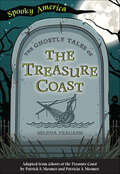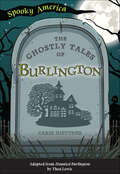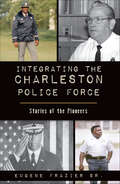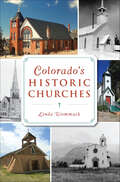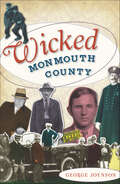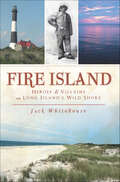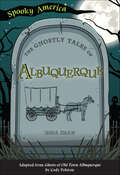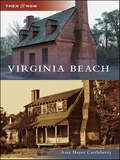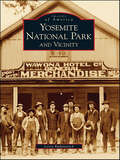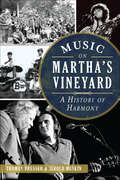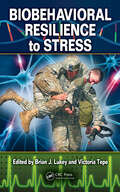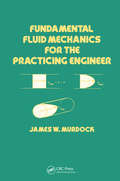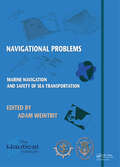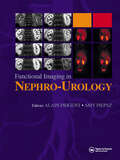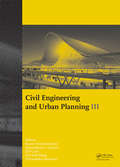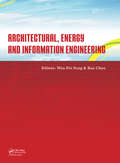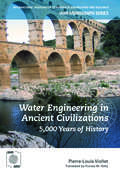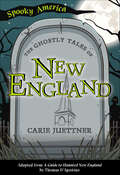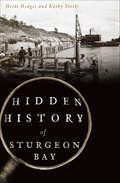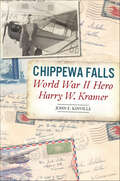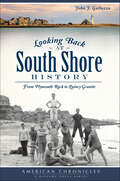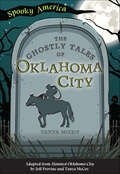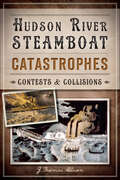- Table View
- List View
The Ghostly Tales of the Treasure Coast (Spooky America)
by Selena FragassiGhost stories from Treasure Coast, Florida have never been so creepy, fun, and full of mystery! The haunted history of Treasure Coast comes to life—even when the main players are dead. Visit the Driftwood Resort and catch a glimpse of past tenants who checked in, but never checked out. Or see a show at the Sunrise Theatre, but expect to be distracted by the specters who call this place home. Dive into this spooky chapter book for suspenseful tales of bumps in the night, paranormal investigations, and the unexplained; just be sure to keep the light on.
The Ghostly Tales of Burlington (Spooky America)
by Carie JuettnerGhost stories from Burlington, Vermont have never been so creepy, fun, and full of mystery!The haunted history of Burlington comes to life—even when the main players are dead. Visit the Howard Opera House for a spectral show. Or spend the night at the South Meadow on Raymond Place, but don&’t count on getting much sleep while surrounded by restless spirits. Dive into this spooky chapter book for suspenseful tales of bumps in the night, paranormal investigations, and the unexplained; just be sure to keep the light on.
Integrating the Charleston Police Force: Stories of the Pioneers (American Heritage)
by Eugene Frazier Sr.The civil rights era in the United States was a turbulent time of struggle and protest, with groups making history all across the nation. African American police officers in Charleston were immersed in their own battle to integrate local law enforcement agencies. These pioneers endured hatred and resentment within the department and sometimes from those they were sworn to protect. Lieutenant Eugene Frazier, Detective George Gathers and others fought the establishment while climbing the ranks to solve some of the toughest crimes that Charleston has ever seen. Join Frazier as he recounts the true stories of those who fought for equality.
Colorado's Historic Churches (Landmarks)
by Linda WommackColorado's houses of worship reflect the same trademark resourcefulness and fortitude that the pioneers and history makers demonstrated throughout the state's history. Our Lady of Guadalupe Catholic Church, established in 1854, remains the state's oldest church. Formed by a group of African American settlers, including former slaves, Zion Baptist became Colorado's first black congregation on November 15, 1865. On May 23, 1868, famed frontiersman Christopher "Kit" Carson died in the historic chapel at Fort Lyon. And thanks to con artist Jefferson Randolph "Soapy" Smith, who raised $600, Creede erected its first church in 1892. From notable parishioners to murders in two separate Denver churches, historian Linda Wommack surveys the heritage and wealth of holy houses in the Mile High State.
Wicked Monmouth County (Wicked)
by George JoynsonDuring the early twentieth century, Monmouth County saw more than its fair share of crime, conspiracy and corruption. In the midst of the Prohibition and Great Depression Eras, Detectives Jacob Rue, William Mustoe ("the man who could make a horse talk") and Harry Crook investigated, and sometimes participated in, much illegal activity. The careers of these fascinating men included investigations of brutal murders, ruthless gangsters, an attempted cyanide poisoning, the kidnapping of the Lindbergh baby and a search for a vicious escaped leopard. From burglaries and bootleggers to speakeasies and swindlers, join historian George Joynson as he uncovers some of the county's seediest stories.
Fire Island: Heroes & Villains on Long Island's Wild Shore
by Jack WhitehouseFire Island, or Great South Beach as it is also known, is a 32-mile long sliver of a barrier beach located just off the South Shore of Long Island. Always a wild, lonely and untamed wilderness, its shores, waterways and the lands surrounding it have given us innumerable stories -- some inspirational, some frightening, but all of them intriguing. The stories in this book portray people and events from the island's earliest days, when it served Native Americans as a rich hunting, fishing and whaling site until the present day and its use as a U.S. National Seashore and National Wilderness Area.
The Ghostly Tales of Albuquerque (Spooky America)
by Jessa DeanGhost stories from the Duke City have never been so creepy, fun, and full of mystery! The haunted history of Albuquerque comes to life--even when the main players are dead. Hear the clinking of spurs against ghostly cowboy boots walking through the High Noon Restaurant. Or witness the lights flicker at the Church Street Café. Stop by La Hacienda restaurant and perhaps dine with a presence from another realm! Dive into this spooky chapter book for suspenseful tales of bumps in the night, paranormal investigations, and the unexplained; just be sure to keep the light on.
Virginia Beach
by Amy Hayes CastleberryVirginia Beach offers a variety of attractions, but few who visit know that there is an area with a history that dates back to the 17th century. Many early structures remain intact and appreciated, while others fell into ruin and exist only in photographs and memories. Then & Now: Virginia Beach is a road trip through the past and present.
Yosemite National Park and Vicinity
by Leroy RadanovichThe astonishing scenery of Yosemite National Park is known throughout the world, primarily for the soaring granite outcroppings and graceful waterfalls around Yosemite Valley. But this park is much larger than just the valley. Relatively few visitors get to experience Yosemite�s vast expanses, whether south to Wawona and Fish Camp or east to White Wolf and Tuolumne Meadows. Indeed, it was John Muir�s efforts to protect the meadows and hills around the valley that ultimately led to the establishment of Yosemite National Park in 1890. The state park, which had been established in 1863 and consisted of Yosemite Valley and the Mariposa Grove of Big Trees, was added to the federal park in 1913.
Music on Martha's Vineyard: A History of Harmony (Music Ser.)
by Thomas Dresser Jerold MuskinMartha's Vineyard has a rich musical legacy that stretches back to the earliest drumbeats of the Wampanoags and the whaling chanteys of the nineteenth century. Returning Civil War veterans formed the island's oldest continuous music ensemble, the Vineyard Haven Band. Vineyarders embrace all things musical, from choral and string ensembles to singers and songwriters. Discover this melodious history from the early twentieth-century dance bands at the Tivoli ballroom, through the war years, the piano bars and the nascent folk music scene at the Mooncusser Cafe, where Carly Simon and James Taylor played their first licks. Authors Thomas Dresser and Jerry Muskin explore the homegrown music scene and the summer stars who keep islanders and visitors moving to the beat.
Contemporary Targeted Therapies in Rheumatology
by Peter E Lipsky Josef S SmolenTargeted therapies of rheumatic diseases have become a reality and have completely changed patient care as well as patient expectations. Initial success with therapies aimed at blocking TNF and IL-1 has stimulated the development of additional targeted approaches focused on other cytokines as well as specific cells and pathways involved in the path
Electromagnetic Modeling by Finite Element Methods (Electrical and Computer Engineering)
by João Pedro Bastos Nelson SadowskiUnlike any other source in the field, this valuable reference clearly examines key aspects of the finite element method (FEM) for electromagnetic analysis of low-frequency electrical devices. The authors examine phenomena such as nonlinearity, mechanical force, electrical circuit coupling, vibration, heat, and movement for applications in the elect
Biobehavioral Resilience to Stress
by Victoria Tepe Brian J. LukeyMilitary service involves exposure to multiple sources of chronic, acute, and potentially traumatic stress, especially during deployment and combat. Notoriously variable, the effects of stress can be subtle to severe, immediate or delayed, impairing individual and group readiness, operational performance, and ultimately‘survival. A comprehensive co
Fundamental Fluid Mechanics for the Practicing Engineer (Mechanical Engineering)
by James W. MurdockA step-by-step guide, containing tutorial examples that serve as models for all concepts presented. This text contains properties of nearly 50 fluids, including density and viscosity data for compressed water and superheated steam, and characteristics of areas, pipes and tubing.
Marine Navigation and Safety of Sea Transportation: Navigational Problems
by Adam WeintritThe TransNav 2013 Symposium held at the Gdynia Maritime University, Poland in June 2013 has brought together a wide range of participants from all over the world. The program has offered a variety of contributions, allowing to look at many aspects of the navigational safety from various different points of view. Topics presented and discussed at th
Functional Imaging in Nephro-Urology
by Alain Prigent Amy PiepszFormulated by members of the International Scientific Committee of Radionuclides in Nephro-urology (ISCORN), Functional Imaging in Nephro-urology is not a textbook on uronephrology or radionuclides in nephro-urology, or even a book on new techniques in imaging. What the editor and authors provide here is a unique opportunity to evaluate the strateg
Civil Engineering and Urban Planning III
by Kouros Mohammadian Konstadinos G. Goulias Elif Cicek Jieh-Jiuh Wang Chrysanthos MaraveasCivil Engineering and Urban Planning III addresses civil engineering and urban planning issues associated with transportation and the environment. The contributions not only highlight current practices in these areas, but also pay attention to future research and applications, and provide an overview of the progress made in a wide variety of topics
Architectural, Energy and Information Engineering: Proceedings of the 2015 International Conference on Architectural, Energy and Information Engineering (AEIE 2015), Xiamen, China, May 19-20, 2015
by Ran Chen Wen-Pei SungThis proceedings volume brings together selected peer-reviewed papers presented at the 2015 International Conference on Architectural, Energy and Information Engineering (AEIE 2015), held July 15-16, 2015 in Hong Kong, China. The proceedings are divided into two parts, Architectural, Energy and Environmental Engineering and Information Enginee
Water Engineering inAncient Civilizations: 5,000 Years of History (IAHR Monographs)
by Pierre-Louis ViolletThis new book offers an engineer's perspective on the history of water technology and its impact on the development of civilisation. A Second Edition and translation into English of the French book "L'Hydraulique dans les Civilisations Anciennes".Water professionals, engineers, scientists, and students will find this book fascinating and invaluable
The Ghostly Tales of New England (Spooky America)
by Carie JuettnerGhost Stories from America's first colonies have never been so creepy, fun, and full of mystery!New England's haunted Yankee history comes to life--even when the main players are dead. Meet the Mad Doctor who lurks in the White Mountains, learn what really happened at Spooner Well, and tread among the spirits in Mystic Seaport. Dive into this spooky chapter book for suspenseful tales of bumps in the night, paranormal investigations, and the unexplained; just be sure to keep the light on.
Hidden History of Sturgeon Bay (Hidden History)
by Heidi Hodges Kathy SteebsBeyond the stunning beauty of Wisconsin's Sturgeon Bay lies a hidden past of colorful characters, tragic shipwrecks and compelling community achievements.Arriving as an immigrant to the town, Joseph Harris Sr. became a founding father, creating the Door County Advocate newspaper and leading a campaign to construct the Sturgeon Bay Ship Canal. More than one hundred local volunteers formed the ranks of Company F, nicknamed Les Terribles by the French for their bravery and sacrifice in World War I. After surviving the Civil War, former slave Peter Custis endured unimaginable tragedy while forging a life in the city.Authors Heidi Hodges and Kathy Steebs expose the forgotten history of Sturgeon Bay. It's a story of dogged perseverance.
Chippewa Falls World War II Hero Harry W. Kramer (Military)
by John E. KinvilleChippewa Falls' First World War II Casualty Young Harry Wellington Kramer was looking for adventure and a leg up in Depression-era Wisconsin. He found both aboard the Navy battleship USS California . Traveling across the western United States and the Pacific Ocean, Harry was quick to share his experiences with family and friends in Chippewa Falls. As he realized his dreams and served his country, his parents anxiously followed the developments that would lead to America's involvement in World War II. All of these events converged with the attack on Pearl Harbor, in which Harry was tragically killed fulfilling his duties. Though gone, Harry W. Kramer is not forgotten. Compiling thirty-three letters between Harry and home, local author and history teacher John E. Kinville tells the story of a life cut short but well lived.
Looking Back at South Shore History: From Plymouth Rock to Quincy Granite (American Chronicles)
by John J. GalluzzoFrom Plymouth Rock to Quincy granite, the South Shore of Boston has been a place of revolution, relaxation and revelation. Artists have gained inspiration from the meeting of sea and shore, enemy navies have targeted its strategic ports and, in better days, merrymakers have sought its warming sun, cooling breezes, amusement parks and historic and natural landmarks. The Toll House Cookie, the song "When the Red, Red Robin (Comes Bob, Bob, Bobbin' Along)" and the U.S. Navy's rallying cry "Don't give up the ship " all were South Shore born. John Galluzzo, author of "The North River: Scenic Waterway of the South Shore" and "When Hull Freezes Over," gathers the best of his "Look Back" column in this compilation of historic vignettes from "South Shore Living" magazine.
The Ghostly Tales of Oklahoma City (Spooky America)
by Tanya McCoyGhost stories from Oklahoma City have never been so creepy, fun, and full of mystery!The haunted history of OKC comes to life—even when the main players are dead. Visit the Overholser House and catch a glimpse of its original occupants, one of the wealthiest families to live in Oklahoma City. Or drive past Kitchen Lake and, perhaps, keep an ear out for phantom babies crying in the night. Dive into this spooky chapter book for suspenseful tales of bumps in the night, paranormal investigations, and the unexplained; just be sure to keep the light on.
Hudson River Steamboat Catastrophes: Contests and Collisions (Disaster)
by J. Thomas AllisonBeginning in the mid-1800s, steamboats carried people between New York City and the Albany area on the Hudson River. Romantic images lull us into believing it was a quiet means of travel, but a crowded river, faulty equipment and the bravado of the captains resulted in at least one major catastrophe every year. Night boats collided and sank, carelessness caused boiler explosions, races put passengers at risk and fires would quickly swallow the wooden vessels. The grand "Empire of Troy "suffered many collisions. The "Swallow" broke in two on a rock, "Reindeer"'s explosion took forty lives at once and the "Oregon" and "C. Vanderbilt" entered into an epic and dangerous race. Collected from eyewitness accounts, these are some of the most exciting and frightening stories of peril aboard steamboats on the Hudson River.
